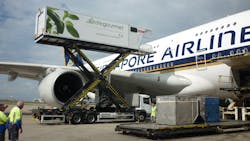Ground support personnel aren’t always working on the ground. Some tasks, including loading cargo, assisting passengers with limited mobility, providing catering or cleaning services or aircraft maintenance, may require “working at height” and taking necessary safety precautions, which include utilizing the proper equipment and training.
“Falls from elevated working surfaces (at or greater than 4 feet above the next level) present a significant risk of death or serious injury to workers. Falls from aircraft working surfaces, work platforms, ladder stands and aerial devices are potential sources of serious injuries and fatalities. Falls are unplanned events and individuals who believe that they will be able to ‘catch’ themselves and prevent the fall are generally mistaken,” wrote Robert Carty, then-acting executive director of Flight Standards Service (FS), introducing FAA Order 3900.65A in 2021.
The order establishes the minimum requirements for fall protection for employees of FS, which promotes safe air transportation by setting the standards for certification and oversight of airmen, air operators, air agencies and designees.
FAA Order 3900.65A states fall prevention measures may involve the installation of guardrail systems on ladder stands and platforms, guarding of wall openings using standard guardrail systems, and properly covering floor holes and openings when not in use.
Safety Standards
Depending on the specific work and equipment being used and sometimes who is doing the work, different standards or guidelines may be applicable.
ANSI A92.7-2014, for example, addresses Airline Ground Support Vehicle-Mounted Vertical Lift Devices, and the Scaffold & Access Industry Association is the secretariat of the A92 committee.
Another standard, ANSI A14.7, is the safety standard for mobile ladder stands and mobile ladder stand platforms and is undergoing review.
The American Ladder Institute (ALI) is approved by the American National Standards Institute (ANSI), as the developer of safety standards for the ladder industry. Conformance to ALI standards is voluntary; ALI does not approve or endorse any product. Standards are technical specifications, which prescribe rules governing the safe construction, design, testing, care and use of various types of ladders. Standards are developed on a five-year renewal cycle by subcommittees comprised of industry experts.
“Some ANSI standards are focused primarily on standardization and other ANSI standards, such as the A14.7 standard, are focused on both standardization as well as safety,” says Bill Switalski, P.E., of Switalski Engineering Inc., who is the chairman of the A14.7 standard. “Clearly, any product that involves elevating people to higher levels involves safety risks, and ladder stands are certainly no exception. The accident and personal injury history that has established itself throughout the decades is reflected in safety standards so that users are informed of the ways to properly utilize the products to minimize their risk of injury. In addition, the misuses of products are also reflected in safety standards to inform users of those risks and misuses that have led to accidents in the past.
“The primary goal of any safety standard is to reduce accidents,” he continues. “The standards also standardize those safety features built and engineered into the products and judged to be sufficiently critical to the cause of safety, so that all manufacturers of like products in the United States include those safety features.”
There is an ongoing effort to re-develop, modernize, improve and expand ANSI A14.7. Switalski says, “Most of the revisions that are in committee discussion center around revisions that were made by the Department of Labor to the OSHA (Occupational Safety and Health Administration) regulations pertaining to Walking and Working Surfaces (29 CFR 1910 Subpart D). There are more stringent requirements placed upon employers with regard to training and supervisory responsibilities over employees who utilize Mobile Ladder Stands and Mobile Ladder Stand Platforms. The next version of the standard will reflect the OSHA revisions since they are considered part of the law.”
ANSI currently requires all standards either be revised or reapproved every four years, but not more than 10-year intervals. ANSI A14.7 exceeded the 10 years, so the standard was administratively withdrawn in January 2022.
“When the current standard is completed, ANSI will treat it as a brand-new standard as opposed to a revision of the A14.7-2012 standard,” Switalski says. “This is due to the withdrawal of the 2012 standard. There is also no guarantee that the new standard will keep its ANSI A14.7 designation, but that decision lies with ANSI.”
Other areas of the standard that are undergoing revision include the on-product label durability testing requirements, he says.
“This is due to the fact that the label manufacturers have transitioned from tests prescribed by the American Society of Testing and Materials (ASTM) to a testing standard developed by Underwriters Laboratories (UL),” Switalski explains.
Also, he says, the Care and Use section of the standard is being expanded to reflect safe use requirements based upon input from manufacturers of the products with regard to how their products have been misused and/or abused.
Ground Support Equipment
Various pieces of ground support equipment help ground service providers work above ground.
For example, Mallaghan produces products such as deicers, cleaning and catering trucks, fire rescue stairs, maintenance platform lifts, medical lifts for passengers with reduced mobility (PRM) and lavatory service trucks.
Mallaghan’s GSE is designed and manufactured in line with EN standards and IATA recommendations, according to Marcel Bernhardt, regional sales manager at Mallaghan.
“Our bespoke solutions include platforms with extendable handrails and safety gates, swivel platform leading edge and anchor points for safety harness,” he says. “We also ensure warning labels and advice are in place ahead of handovers to make operators aware of any risks associated with the height.”
Safety features are designed for ground service personnel as well as passengers.
At Stinar, one of its most popular products, especially among airports without jetways, is the Disabled Passenger Lift. The truck-mounted aircraft service vehicle is designed for transporting people with injuries, disabilities or limited mobility to and from aircraft.
To transfer passengers from ground level to the van body, there’s a hydraulic rear lift gate. A double scissors lift mechanism enables raising the van body to aircraft door threshold heights of 90 to 228 inches, and the van body has a rated capacity of 3,000 lbs. Whenever the van body is raised, hydraulically operated stabilizers are used. The scissors lift and stabilizers are powered by a hydraulic pump driven from the truck’s transmission, and the hydraulic pump functions only when the power take-off (PTO) switch is turned on from the cab control station.
Craig Kruckeberg, CEO/CVO at Stinar, says sensors prevent the lift from raising or lowering if it senses anyone on the front platform bridging the gap between the van body floor and the aircraft door threshold.
An intercom system permits communication between the van body and the cab. Cameras and monitors can enable operators to see what’s going on around the equipment or inside the cabin, Kruckeberg adds.
When the lift is in the air, Kruckeberg explains two floodlights on the front of the unit and two floodlights on the rear illuminate about 20 feet around the vehicle.
Other features include diamond plate flooring, telescoping side rails with rubber bumpers on the extended railings and a full-width rubber bumper at the front of the platform. The railings on the platform sides are painted in safety yellow.
“Every unit that we ship out, we fly in and train everybody that’s going to be an operator,” Kruckeberg says.
He encourages managers to ensure their employees are well trained and reminds equipment operators not to rush while operating the equipment.
JETechnology Solutions, Inc. (JSI) manufactures military and commercial aircraft maintenance stands and fall prevention equipment.
Mitchell Hamilton, USMC (Ret.), business development manager, JETechnology Solutions, describes the company’s equipment as passive protection.
“You’re just walking onto a platform to do maintenance on an aircraft,” he says.
Basic features include things like anti-slip platforms (including traction tread or grip strut), railings (typically 42 inches high) and 4-inch high kickplates.
If the stand needs to be positioned in a different location and the railing needs to be moved, he says most of JSI’s stands do not require tools to remove the railings.
Underneath the platform, extension sliders with rubber padding allow each stand to conform to the shape of the aircraft to eliminate gaps.
“The whole goal is to allow the maintainer to have access to any part of the aircraft,” Hamilton says. “If you have a full wraparound stand, that wraps around the whole aircraft, it allows the maintainers to access the aircraft without having to worry about falling to the ground.
“Our job is to make sure to hit every area, inch and cranny of that aircraft, so that these maintainers stay safe while working.”
VR Training
Serious Labs offers an airline module as part of its Mobile Elevated Work Platforms (MEWP) Virtual Reality (VR) Operator Equipment Training Simulator. The airline module provides hands-on training and assessment in a risk-free environment for operators who are working on or near the aircraft fuselage.
“The module training covers precise positioning and placement near challenging curved structures,” says Wade Carson, senior director of product development at Serious Labs. “This allows operators to increase risk awareness and develop the skills needed to position the MEWP safely next to the aircraft — while reducing the risk of touching or damaging the aircraft with the equipment.
“It’s important to make sure that the operators have heightened risk awareness when they’re doing the work in and around the aircraft, and that’s really what we’ve focused on,” Carson continues.
According to Carson, the MEWP simulator offers an experience so realistic that it can replace a real boom or scissor lift for training. The simulator measures the behaviors of the operator and provides 97 percent predictivity of actual operator skills, he explains.
“It provides data about the risks and the human error that any of the workers bring to their work on and around the airplane. That’s really the value that it gives to the organization; the management team can review the record of training for each individual and have conversations about those workers and the gaps that they are demonstrating,” Carson says. “This allows them to do some refresher training or upskilling to increase the operators’ risk awareness and reduce the human error component of it.”
Fall Incidents at Work
Circumstances associated with fall incidents in the work environment frequently involve:
- Slippery, cluttered, or unstable walking/working surfaces
- Unprotected edges
- Floor holes and wall openings
- Unsafely positioned ladders
- Misused fall protection
- Federal regulations and industry consensus standards provide specific measures and performance-based recommendations for fall prevention and protection. However, persistent unsafe practices and low safety culture across many industries define steady fall injury rates year after year.
- Successful reduction of fall injury and death rates requires continued concerted efforts of regulators and industry leaders, professional associations and labor unions, employers and employees, safety professionals and researchers in enhancing the work environment, implementing new effective fall prevention and protection technologies, and improving the work safety culture through educating the workforce. As a leader in occupational safety research, NIOSH plays a key role in these complex fall-injury prevention efforts.
Source: CDC
About the Author
Rebecca Kanable
Assistant Editor
Rebecca Kanable, a veteran journalist, worked with Endeavor Business Media's aviation group from 2021 to 2024 as assistant editor of Airport Business, AMT and Ground Support Worldwide. She previously worked for various publications, including trade magazines and newspapers.

